By going through these CBSE Class 12 Biology Notes Chapter 8 Human Health and Disease, students can recall all the concepts quickly.
Human Health and Disease Notes Class 12 Biology Chapter 8
→ Health is a state of complete physical, mental and social well-being. It is not just the absence of diseases. Health may be defined as a state of the body when all the organs and systems are functioning properly and a perfect balance is maintained between the environment and the body.
→ The disease may be identified as any condition which impairs health or interferes with the normal functioning of the body due to one or another reason. It is any functional change from the normal state which causes discomfort or disability.
→ Any factor or substance which causes disease by its excess or deficiency or absence is called a disease agent.
→ The disease agents may be biological (e.g. virus, bacteria, fungi, protozoans, helminths, and anthropods) they are called pathogens; or Nutrient agents, e.g. food components viz. proteins, fats, carbohydrates, minerals, vitamins, and water; or chemical agents, may be exogenous or endogenous ones. Exogenous agents enter the body from outside e.g.-pollutants such as fumes, dust, metals, gases, etc., or allergens such as pollen and spores.
Endogenous chemical agents are formed inside the body, e.g. hormones, enzymes, uric acid, etc.; or Physical agents such as humidity, pressure, radiation, heat, cold, electricity, and sound; or mechanical agents such as chronic friction or other mechanical forces which cause a sprain, fracture or dislocation, etc; err genetic agents which cause genetic disorders or underdeveloped organs.
→ Diseases are broadly classified into two types as
- Congenital disease and
- Acquired diseases.
→ Congenital disease is anatomical or physiological abnormalities that are present at the time of birth. These may be single gene mutation, e.g. phenylketonuria, albinism, sickle-cell anemia, color blindness, hemophilia, etc., or chromosomal aberrations e.g. Down’s syndrome, Klinefelter’s syndrome, or Turner’s syndrome. These are further transmitted to the children.
→ Harelip and cleft palate are some environment-related congenital diseases that are not transferred to children.
→ Acquired diseases: These develop after birth. They may be communicable or non-communicable diseases.
Classification:
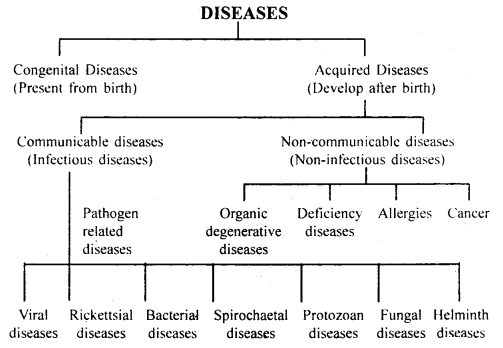
→ Acquired diseases are further of two types – Communicable and non-communicable. Communicable diseases are infectious which are caused by pathogens. Non-communicable diseases are non-infectious ones that remain confined to the diseased person only.
These are of four types:
- Organic diseases occur due to the malfunctioning of important organs such as heart diseases, epilepsy.
- Deficiency diseases are produced by a deficiency of minerals, nutrients, vitamins, and hormones such as beriberi, diabetes, goiter, etc.
- Allergies are caused when the body becomes hypersensitive to some foreign substance e.g. Hay fever,
- Cancer is caused by the uncontrolled growth of certain tissues in the body.
→ Communicable diseases are classified into seven types:
- Viral diseases e.g. smallpox, chickenpox, polio, common cold, etc.
- Rickettsial diseases are caused by obligate intracellular parasitic organisms known as rickettsias, e.g. typhus fever, Q fever, Rocky Mountain spotted fever, etc.
- Bacterial diseases e.g. diphtheria, tetanus, food poisoning, etc.
- Spirochaetal diseases are caused by long, spiral, corkscrew-shaped bacteria called spirochaetes e.g. syphilis,
- Protozoan diseases are caused by protists, e.g. amoebic dysentery, malaria, kala-azar, sleeping sickness, etc.
- Fungal diseases are caused by non-green heterotrophic organisms, fungi e.g. ringworm and athlete’s foot,
- Helminth diseases are caused by flatworms and ringworms e.g. liver rot, taeniasis, etc.
→ Typhoid is caused by gram-negative bacteria, Salmonella those commonly found in the human intestine. It is a communicable disease, spread through the intestinal discharge of typhoid carriers. Its incubation period is 1 – 3 weeks.
Its symptoms include headache, typical typhoid fever which increases in the afternoon and enhances every day, in a second week its high and decreases during the third and fourth week, lesions of the intestinal mucosa, hemorrhage, ulcer of the intestine, red rashes on chest and upper abdomen. It is confirmed by S.typhi bacterium detection in stools or blood and also by the Widal test.
As typhoid spreads through contaminated food and water, precautions should be taken for screening of water and food sources, proper sanitation of human feces.
Its therapy includes
- Thyphoral is an oral vaccine,
- TAB – this vaccine provides immunity for 3 years,
- Chloramphenicol, ampicillin, and chloromycetin are effective drugs against typhoid bacterium.
→ Pneumonia is a lung infection caused by bacteria like Streptococcus pneumonia and Haemophilus influenza or mycoplasma or viruses. This is an airborne disease spread through cysts present in the patient’s sputum. Its incubation period is 1 – 3 days. Pneumonia is characterized by lymph collection and mucus in the bronchioles and alveoli, thus decreasing the respiratory efficiency of the lungs. It includes fever, chills, cough, and headache. In severe cases, the fingernails and lips may turn grey to bluish.
The bacteria present in the body secretion of the patient are released out as aerosols or droplets which are inhaled by healthy person and cause infection. It also spread by glasses and utensils sharing with the patient so the best precaution is the isolation of the infected person. It is treated, with penicillin, flucloxacillin, etc. antibiotics.
→ The common cold is caused by a large number of viruses that belong to a group ‘rhinoviruses. It is the most infectious human disease. These viruses infect the nose and respiratory passage but not the lungs of the patient. Its symptoms are nasal congestion, discharge, sore throat, cough, headache, tiredness, etc. It lasts for 3 to 7 days. The infection spreads through droplets from sneezes or cough, through contaminated objects like books, cups, doorknobs, computer keyboard pens, mice, etc.
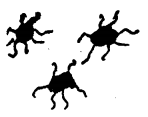
Salmonella typhosa

Diplococcus pneumoniae
→ Amoebic dysentery or Enteritis or Amoebiasis is caused, by an intestinal endoparasitic protozoan, Entamoeba histolytic which inhabits the large intestine. It may also spread to the lower part of the small intestine, liver, lungs, and brain. E. histolytic occurs in two forms (diagonal) minute form, its an absorptive stage and undergoes encystment and magma form, its large-sized, destroys epithelial cells and holozoic stage. Its main sources of infection are drinking water and food, contaminated by the fecal matter of infected person. Houseflies act as carriers and transfer the parasite from feces to food products.
Stool detection of the patient shows the presence of E. histolytic. The symptoms include constipation, abdominal pain, and cramps, stools with excess mucous, and blot clots. The protozoan secretes leading to ulcers.
Its precautions include
- proper sanitary conditions,
- coverage of tables to prevent contamination by vectors,
- proper washing of fruits and vegetables before eating. Its treatment is done by antibiotics like Terramycin, erythromycin, aureomycin, and metronidazole.
→ Malaria is a vector-borne disease which is caused by the protozoan parasite Plasmodium. It is caused by toxic pigment hemozoin from RBC’s Hb. This is produced when RBC are destroyed by developing stages of the Plasmodium. Plasmodium is digenetic (two hosts) and triphasic. The primary host is the female Anopheles mosquito and the secondary host is human beings.
Three phases include asexual schizogony (in liver and RBCs of man), sexual cosmogony (starts in RBCs and completes in mosquito’s stomach), asexual sporogony (stomach of mosquito). Malaria is of several types which are caused by different species of Plasmodium. Malaria caused by Plasmodium falciparum is most dangerous, it is called malignant malaria and it can be fatal.
Plasmodium enters the human body through the Anopheles mosquito. The parasite multiplies within the RBCs and ruptures the cells. Symptoms include headache, chill, shivering, nausea, muscular pain, recurring fever every 3rd or 4th day, increase in pulse and respiration rate, sweating, and anemia.
Its symptoms are divided into three stages:
- cold state,
- hot stage and
- sweating stage.
The mosquitoes acquire the parasite from infected persons and transmit it to healthy individuals.
Its precautions include
- wire gauzing of doors and windows etc.,
- using mosquito nets,
- use of mosquito- repellents.
- spraying insecticides like D.D.T. and B.H.C.,
- do not allow any stagnant water. Its treatment is done by quinine, chloroquine, palustrine, Daraprim, etc., anti-malarial drugs.
→ Filariasis is caused by the filarial worm, Wuchereria ban crafti and Wuchereria malayi. The worm is digenetic, its primary host is man, and the secondary or vector host is mosquitoes Aedes and Culex. It causes slowly chronic inflammation of organs for many years.
They are found in lymph vessels and lymph nodes and due to infection the lymphatic vessels of lower limbs become enlarged due to blockage and chronic inflammation. The disease is called elephantiasis or filariasis. Genital organs are also affected. This causes enormous swelling of legs, scrotal sacs, breasts, etc.
The pathogens are transmitted through the bite of female mosquito vectors. Its precautions are the same as for malaria. Its treatment includes Hetrazan and diethylcarbamazine.
→ Ascariasis is caused by intestinal endoparasite of man, Ascaris lumbricoid known as roundworm. It is a monogenetic helminth that spreads through water, vegetables, fruits that are contaminated with the eggs of the parasite. Its symptoms include abdominal pain, indigestion, weakness, anemia, nausea, vomiting, diarrhea, internal bleeding, muscular pain, fever, etc.
Heavy infection may cause pneumonia, hepatitis, blockage of the intestine, convulsions, etc. Flies and cockroaches serve as vectors for spreading the diseases. It is diagnosed by doing stool test, Dermol test or Scratch test, its precautions are same as for Amoebic dysentery. Its treatment is done by Hexyl-resorcinol crystals, a mixture of oil of chenopodium and tetrachloroethylene.
→ Ringworms are a common infectious disease caused by fungi Microsporum, Trichophyton, Candida, and Epidermophyton. Their symptoms include dry and scaly lesions on skin, nails, and scalp. These are accompanied by intense itching.
Moisture and warmth help in fungal growth. It’s most likely to grow in skin folds like the groin and between the toes. These generally spread from soil or sharing towels, clothes, or comb with an infected person. These are treated with antifungal ointments.
→ Vaccination is a common method of preventing the infection of microorganisms like bacteria and viruses. Infectious diseases like polio, diphtheria, pneumonia, and tetanus are controlled to great extent by vaccination. Smallpox is completely eradicated by vaccines and immunization programs. Various antibiotics are also very effective against infectious diseases.
→ Disease resistance or immunity is the ability of an organism to resist disease. Immunology is the branch of science which deals with immunity. The immune system forms the third line of defense. The immune system can differentiate between self (body cells) and non-self (foreign microbes).
→ Any foreign substance entering the body stimulates an immune response it is called an antigen. The protective chemicals (proteins) produced by the body in response to antigens are called antibodies.
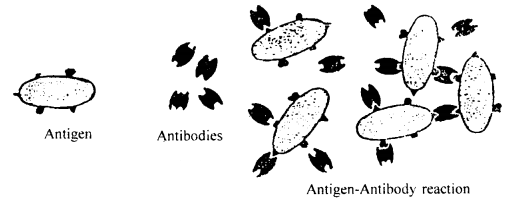
→ Immunity is of two main types:
- Innate immunity and
- Acquired immunity.
1. Innate immunity or inborn or natural immunity is non-specific and present at the time of birth. It is inherited from the mother through the placenta. It provides four different types of barriers to the foreign agents as (a) physical barriers: Skin is the foremost barrier that prevents the entry of microorganisms, similarly, the mucus coating of the epithelial layer lining the respiratory, gastrointestinal, and urogenital tracts also defend the entry of microorganisms,
2. Physiological barriers such as gastric acids, saliva in the mouth, tears, all prevent microbial growth.
3. Cellular barriers, some leukocytes (WBC) like polymorphonuclear leukocytes (PMNL-neutrophils) and monocytes and some lymphocytes (e.g. natural killer) from blood and macrophages from tissue can phagocytose and destroy the invading microbes,
4. Cytokine barriers, virus-infected cells produce anti-viral proteinous molecules called interferons, which protect the unattacked cells from viral attack.
→ Acquired or adaptive immunity is not present from birth but is acquired or developed by the organisms in response to a disease. It is pathogen-specific and is characterized by memory. When the body encounters any antigen (pathogen) the lymphocytes produce antibodies which are termed as a primary response, it’s of less intensity.
Lymphocytes also provide immunity against further attack, a subsequent encounter with the same pathogen produces a highly intensified secondary or anamnestic response. The acquired immunity may be temporary (influenza) or permanent (measles, mumps, polio, smallpox, etc.) for life long.
→ Acquired immunity is of two types:
- Active or natural immunity is developed by antibodies from the individual’s body,
- Passive or artificial immunity: In it, readymade antibodies are obtained from human or animal serum, who had recovered from the same infection and injected into the patient. It is known as inoculation
e.g. tetanus treatment, snake bite, etc.
→ The primary and secondary immune responses are carried out with lymphocytes. Lymphocytes are a kind of agranulocytes of leucocytes (WBC) of blood. Lymphocytes are of two types: B-lymphocytes and T-lymphocytes. Both types of lymphocytes are formed from the stem cells called haemocytoblasts in the bone marrow and undergo further processing.
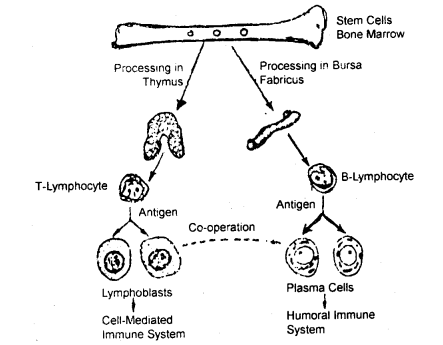
Showing formation of lymphocytes
→ B-lymphocytes produce antibodies when stimulated by an antigen. After stimulation one B-lymphocyte synthesize RNA, divide rapidly and differentiate into the RER-rich histologically distinctive plasma cells. A group of plasma cells is called a clone. They produce antibodies at a rate of about 2000 molecules per second. These antibodies circulate in the lymph to fight antigens. They form the humoral immune system or Antibody-Mediated Immune System (AMIS).
→ An antibody molecule is made up of four peptide chains, two small peptide chains called light chains, and two long heavy chains. An antibody may be designated as H2L. There are five classes of antibodies (immunoglobulins) namely IgM, IgG, IgA, IgD, and IgE. IgG is not abundant in man whereas IgM and IgG cause the lysis of foreign cells.
→ The second type of acquired immune response is Cell-Mediated Immune System (CMIS). It is mediated by T-lymphocytes. T-cells do not secrete antibodies but help B-cells to produce them. T-lymphocytes attack directly the pathogenic microorganisms entering the body or grafts such as transplanted kidney or skin grafts. It also protects the body from its own cells which have become cancerous.
→ Vaccination or immunization is based on the property of memory of the immune system. A preparation of antigenic proteins of pathogen or weakened or inactive pathogen is given. The body produces antibodies against these antigens and neutralizes the pathogenic agent during actual infection. The vaccines also produce memory B and T cells which recognize the pathogen or subsequent exposure and counteract with massive production of antibodies. Vaccines are also produced by recombinant DN A technology where bacteria or yeast produce antigenic polypeptides of pathogens, e.g. hepatitis B vaccine.
→ Allergies are an exaggerated immune response to certain antigens called allergens e.g. dust mites, pollens, animal dung, fur, venom, etc. Allergy symptoms are inflammation of mucous membranes, sneezing, watery eyes, running nose, irritation of upper respiratory tract, rashes, itching, etc. In allergic people, the body develops a primary immune response on encounter with the allergen. B-cells produce antibody IgE. On the next exposure, the body produces a secondary immune response called allergy.
→ The allergens combine with antibody-bound mast cells and basophils. This complexing ruptures the mast cells and basophils, releasing histamine from vesicles called granules. The process of the release of histamine is termed degranulation. The histamine acts as an allergy mediator. It increases the permeability of capillaries constricts smooth muscles in many parts such as those around the bronchioles, causing breathing problems; and stimulates mucous glands. It also widens the small arteries but not the veins.
Thus, the affected area (where histamine has been released receives more blood than it returns. As a result of this, fluid accumulates in the tissue which swells up. This causes allergy.
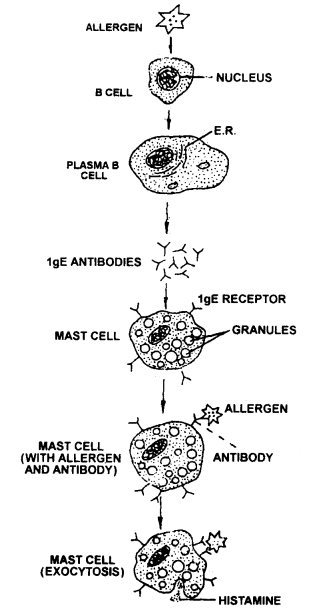
Showing allergic reaction and release of histamines by rupturing of mast cells
→ The immune system sometimes rejects certain tissues of the body as non-self. Due to genetic and other unknown reasons the body attacks self-cells. This is called autoimmunity. The body tissues act as autoantigens and autoantibodies, e.g. Hashimoto’s thyroiditis, systemic lupus erythematosus, rheumatoid arthritis.
→ The immune system plays a role in allergic reactions, autoimmune diseases, and organ transplantation. The immune system consists of lymphoid organs, tissues, cells, and soluble molecules like antibodies. Lymphoid organs help in the origin or maturation and proliferation of lymphocytes.
The primary lymphoid organs are bone marrow and thymus, here immature lymphocytes differentiate into antigen-specific lymphocytes. After maturation lymphocytes migrate to secondary lymphoid organs which are the spleen, lymph nodes, tonsils, appendix, and Peyer’s patches of the small intestine. Here the lymphocytes interact with antigens and then proliferate to become effector cells.
→ Bone marrow provides a suitable environment for the development and maturation of B-lymphocytes. Bone marrow is the main lymphatic organ where all blood cells, as well as lymphocytes, are produced.
→ The thymus is a lymphatic organ, located near the heart beneath the chest bone. It is prominent in children but keeps on reducing with age, by puberty it becomes very small in size. Development and maturation of T-lymphocytes take place in the thymus. It educates the fetal lymphocytes to distinguish between self and non-self.
→ The spleen is the largest component of the lymphatic system. It is bean-shaped, vascular, dark red in color, located in the abdomen below the diaphragm. It consists of red pulp and white pulp. It helps in the destruction of worn-out RBCs, as a reservoir of RBCs, production of antibodies, disposal of foreign elements.
→ Lymph nodes are present at intervals in the course of lymphatic vessels. They contain lymphocytes, plasma cells, and macrophages. They trap the microorganisms and antigens and stimulating the immune response.
→ Lymphatic tissue present in the lining of respiratory, digestive, and urogenital tracts is known as mucosal-associated lymphoid tissue (MALT). Lymphatic tissue present in the gut is called get-associated lymphoid tissue (GALT).
AIDS is an acquired immunodeficiency disease. A detailed account of the retrovirus and the disease has been discussed in detail in previous chapters. Its control and prevention were also discussed.
The figure shows the aids virus.
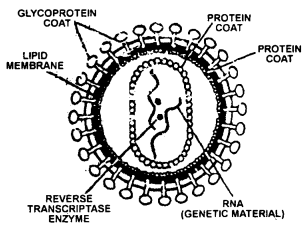
Diagram of AIDS virus
Cancer is a malignant growth or tissue enlargement due to unlimited and uncontrolled mitotic division of some cells known as cancerous cells.
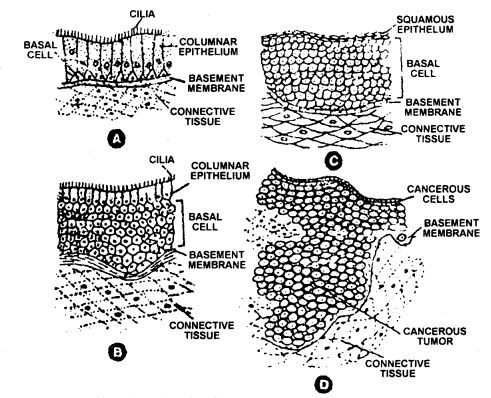
Showing development stages of cancer due to smoking in lung epithelium
Cancerous cells grow rapidly and form a mass of cells called tumors. Tumors are of two types: Benign or non-malignant tumors these remain confined to one place and cause little damage, cancerous or malignant tumors – these are a mass of proliferating cells known as neoplastic cells. They grew rapidly, damage the nearby normal tissue. Cancerous cells divide actively and compete for nutrients with the normal tissue. These cells reach another place through blood and form new tumors. This is called metastasis.
→ Cancer is neither contagious nor hereditary. Factors that cause cancer are called carcinogenic agents. These may be ionizing radiations, e.g. x-rays and gamma rays or non-ionizing rays like U.V rays, chemical carcinogens like beetle and tobacco, aniline dyes, heavy smoking, viral oncogenes, and cellular oncogenes. Cellular oncogenes (c-onc) or protooncogenes are present in normal cells which get activated under certain conditions and become oncogenes.
→ Detection of cancer is done by biopsy and histopathological studies of tissues, blood, and bone marrow for increased cell count (leukemia). X-rays, CT scans, and MRIs are used to detect cancer of internal organs. Mammography is done to detect breast cancer. Pap test is done for cancer detection in the cervix and other genital parts. Monoclonal antibodies against the cancer-specific antigen are coupled to the suitable radioisotope, these antibodies are used further for cancer detection.
→ Cancer is treated with surgery, radiation therapy and immunotherapy, and chemotherapy. Biological response modifiers such as γ – interferons are used to activate the immune response to destroy the tumor.
→ Drugs are normally used for the treatment of diseases. An addictive drug modifies the biological, psychological, or social behavior of an individual by stimulating, depressing, or distorting mind and body functions. This habit of taking drugs beyond voluntary control is called an Addition. Commonly abused drugs include opioids, cannabinoids, and coca alkaloids.
TABLE: SHOWING MAJOR GROUPS OF PSYCHOTROPIC DRUGS WITH EXAMPLES AND EFFECTS
| Type of Drug | Examples | Effects |
| I. Sedatives and tranquillisers (depressant) | Benzodiazephines {eg.. Valium) Barbiturates | Depress brain activity and produce feelings of calmness relaxation, drowsiness, and deep sleep (high doses). |
| II. Opiate narcotics | Opium Morphine. Heroin Pethidine. Methadone | Suppresses brain function, relieves intense pain. |
| III. Stimulants Caffeine (very mild). | Cocaine. Amphetamines | Stimulates the nervous systems makes a person more wakeful, increases alertness and activity, produces excitement. |
| IV. Hallucinogens | LSD. Mescal in. psilocybin. Bhang. Ganja. Charas. Marijuana | Alters thought feelings and perceptions cause illusions. |
Opioids bind to opioid receptors in the central nervous system and gastrointestinal tract. These suppress brain activity and relieve pain. These are called pain killers e.g. opium and its derivatives.
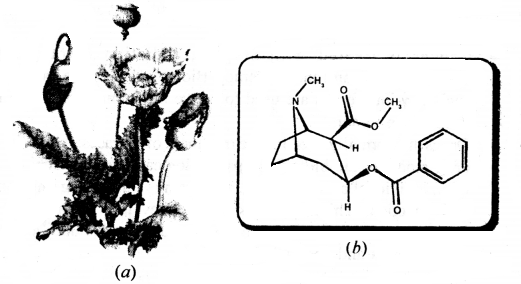
(a) Somniferum (Opium poppy) plant (b) Chemical structure of Morphine
Heroin or smack is diacetylmorphine. It is a white, odorless, bitter crystalline compound. It is formed by the acetylation of morphine, which is extracted from poppy latex. It is a depressant and slows down body functions.
→ The products of the Hemp plant Cannabis Sativa are Bhang, Ganja, Charas, Hashish, and Marijuana. These are less harmful but may lead to opiates addiction. Their active compound is delta-9- tetrahydrocannabinol or THC.
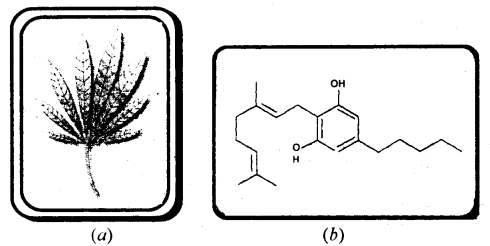
(a) Leaf of Cannabis Sativa
(b) Skeletal structure of cannabinoid molecule

Cocaine or coke is an alkaloid from Erythroxylum coca. It has a potent stimulating effect on the central nervous system, produces a sense of euphoria and increased energy.
→ Datura spp. and Atropabeliadona also have hallucinogenic properties. Cannabinoids are misused by some sportspersons.
→ Other abused drugs are barbiturates, amphetamines, benzodiazepines, and lysergic acid diethyl amides (LSD).
→ The adolescence period is very vulnerable to the mental and psychological development of an individual. Curiosity, adventure and excitement, and experimentation motivate youngsters towards drug and alcohol misuse.
TABLE: SHOWING EFFECTS OF ALCOHOL AND DRUGS
| Combination | Effect |
| Alcohol + barbiturates | Dramatically increased depressant effect |
| Alcohol + antihistamines | Marked drowsiness |
| Alcohol + Valium | The rapid increase in the sedative effect |
| Alcohol + Marijuana or Hashish | Decreased coordination, increased reaction time, impaired judgment |
| Alcohol + Aspirin | Increased risk of damage to the gastric mucosa |
→ Smoking paves the way to hard drugs. Tobacco is derived from Nicotiana tabacum and N, Rustica leaves. Its main constituent is the toxin alkaloid Nicotine. It stimulates the release of adrenaline and nor-adrenaline which cause high blood pressure and increased heartbeat. It is associated with lung cancer, bronchitis, emphysema, coronary heart disease, urinary bladder cancer, throat cancer, gastric ulcer, and oral cavity cancer.
→ Alcohol is obtained from the fermentation of cereals or grains by yeast Saccharomyces cerevisiae and further distillation. It has depressant effects on the central nervous system.
→ The symptoms of addiction include undue excitement, irritable and violent nature, exhausted and drowsy appearance, loss of interest in studies, poor concentration and memory, reduced appetite, vigor, and weight.
→ Parents should keep a watch on their children and seek medical and professional help if needed.
→ Allografting: A graft taken from another person. e.g. skin.
→ Antibody: The proteinous molecules produced to counter the specific antigen.
→ Antigen: A foreign agent which stimulates the immune system to produce antibodies.
→ ARC: AIDS-related complex.
→ Autoimmunity: An immune disorder when the immune system of a person rejects its own body cells.
→ Addiction: Dependency on certain drugs.
→ Anesthetic: Chemical which causes the loss of sensation, e.g. opiates.
→ Benign tumor: Cäncer type which remains localized in the organ affected.
→ Communicable disease: The disease which can be transmitted from an infected person to a healthy person.
→ Cancer: Disease characterized by uncontrolled growth and division leading to tumor formation.
→ Carcinogens: Cancer-causing agents e.g. radiations.
→ Carcinomas: Cancers located in the epithelial tissues. e.g. breast cancer.
→ Congenital diseases: Inborn diseases caused by gene or chromosomal mutations, e.g. hemophilia.
→ Cirrhosis: A liver disease caused by the storage of fats.
→ Co-poisoning: CO of tobacco smoke binds lib of RBCs and decreases their Oxygen carrying capacity.
→ Depressant: Chemical which lowers the activity of CNS, e.g. alcohol.
→ Disease: A condition impairing health.
→ Epidemiology: Mode of transmission of disease.
→ Epidemic: A disease that attacks a large number of people at the same time and in the same region e.g. cholera.
→ Endemic: A disease restricted to a certain region, e.g. sleeping sickness.
→ Gastritis: Inflammation of gastric mucosa.
→ hallucinogens: Chemicals which change thoughts, feelings, and perceptions of a person e.g. LSD.
→ Health: A state of complete physical, mental and social norms.
→ Hypertension: High blood pressure.
→ Immunodeficiency: An immune disorder characterized by a deficiency of B-cells and T-cells in the body.
→ Immunoglobulin: Antibodies (γ-globulins) produced against the antigen.
→ Immunity: Resistance of body towards diseases.
→ Immunosuppression: Immune disorder in which the immune system rejects transplanted organs.
→ Infection: Entry and multiplication of living pathogenic microorganisms in some part of the host’s body.
→ Infestation: Presence of a large number of parasitic organisms on the surface of the host’s body or clothing.
→ Incubation period: Period between infection and appearance of the first symptom of a disease.
→ Leukemia: Blood cancer, increased WBC count of the blood.
→ Metastasis: Spread of cancer.
→ Lymphocytes: Type of WBCs which produce antibodies.
→ Lysozyme: A bacterial protein.
→ Neoplasm: A tumor formed by uncontrolled growth of the tissue in cancer.
→ Neuritis: Inflammation of nervous tissue of the brain.
→ Oncogenes: Cancer-causing genes.
→ Prophylaxis: Prevention of occurrence of a disease.
→ Psychotropic drug: mood-altering drug.
→ Pyrexia: Increase in temperature.
→ Pathogen: An organism causing disease.
→ Pyrogen: A fever-causing substance.
→ Serology: Study f antigen-antibody interactions.
→ Sedative: A chemical that decreases functional efficiency and has a calming effect, e.g. alcohol.
→ Therapy: Mode of treatment of a disease.
→ Tranquilizer: A drug having a calming effect without inducing sleep e.g. valium.
→ Vaccine: An inoculation with dead or weakened or virulent germs, which stimulates the formation of antibodies of the host’s body.
→ Vector: Organism which spreads the disease.